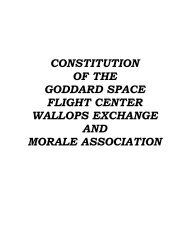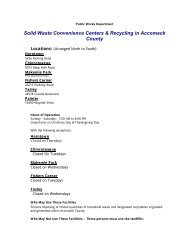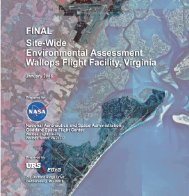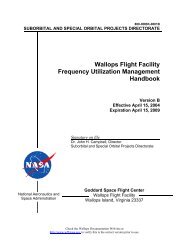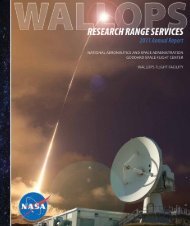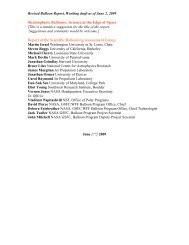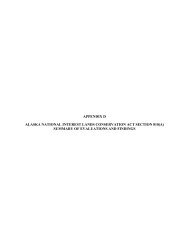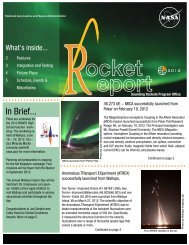Alternative Energy Draft EA - NASA Visitor Center at Wallops Flight ...
Alternative Energy Draft EA - NASA Visitor Center at Wallops Flight ...
Alternative Energy Draft EA - NASA Visitor Center at Wallops Flight ...
You also want an ePaper? Increase the reach of your titles
YUMPU automatically turns print PDFs into web optimized ePapers that Google loves.
Environmental Consequences<br />
Implement<strong>at</strong>ion of solar panels would result in long-term changes to the viewshed <strong>at</strong> the Main<br />
Base. Visual impacts would affect WFF employees and visitors <strong>at</strong> the Main Base, but the solar<br />
panels would not be visible to the public in the area. The solar panels would not substantially<br />
alter the characteristics of the viewshed <strong>at</strong> the Main Base because they would be installed in<br />
areas th<strong>at</strong> are already highly developed (roads, buildings, towers, etc.). Although aesthetics is<br />
highly subjective, because the Main Base is a highly industrialized setting with numerous<br />
antenna arrays and other infrastructure, solar panels should not present a neg<strong>at</strong>ive impact on the<br />
viewshed.<br />
4.5 CUMULATIVE EFFECTS<br />
The CEQ defines cumul<strong>at</strong>ive effects as the “impact on the environment which results from the<br />
incremental impact of the action(s) when added to other past, present, and reasonably foreseeable<br />
future actions regardless of wh<strong>at</strong> agency (Federal or non-Federal) or person undertakes such<br />
other actions” (40 CFR 1500). <strong>NASA</strong> has determined th<strong>at</strong> the Proposed Action altern<strong>at</strong>ives, in<br />
conjunction with the impacts of other WFF projects and oper<strong>at</strong>ions, could result in cumul<strong>at</strong>ive<br />
impacts on some resources.<br />
4.5.1 <strong>Wallops</strong> Research Park<br />
The <strong>Wallops</strong> Research Park (WRP) project intends to cre<strong>at</strong>e an integr<strong>at</strong>ed business park for<br />
aerospace research and development programs, scientific research, commercial space industries,<br />
and educ<strong>at</strong>ional centers. Development of the WRP will take place adjacent to the Main Base <strong>at</strong><br />
WFF over a 20-year period; some development has occurred, but the majority of the Proposed<br />
Action has not been constructed. WRP would consist of a multi-use development cre<strong>at</strong>ed for<br />
non-retail commercial, government space, science research, educ<strong>at</strong>ional facilities, and public<br />
recre<strong>at</strong>ion areas.<br />
4.5.2 North Unmanned Aerial System Airstrip<br />
<strong>NASA</strong> is currently considering the construction of an unmanned aerial system (UAS) airstrip on<br />
north <strong>Wallops</strong> Island. The purpose of the North UAS Airstrip is to provide a venue and<br />
infrastructure to support launch and recovery oper<strong>at</strong>ions for UASs. UASs are small aircraft th<strong>at</strong><br />
serve as pl<strong>at</strong>forms for small science instruments. They are controlled remotely by a pilot on the<br />
ground and are powered by b<strong>at</strong>teries or small model aircraft gasoline engines. The east-west<br />
orient<strong>at</strong>ion of this airstrip would provide an altern<strong>at</strong>ive to the north-south positioning of the<br />
current UAS airstrip on south <strong>Wallops</strong> Island. An <strong>EA</strong> is currently being prepared. The<br />
implement<strong>at</strong>ion d<strong>at</strong>e of the UAS airstrip would occur no earlier than mid-2011.<br />
4.5.3 Shoreline Restor<strong>at</strong>ion and Infrastructure Protection Program<br />
A Shoreline Restor<strong>at</strong>ion and Infrastructure Protection Program (SRIPP) is currently being<br />
planned <strong>at</strong> WFF to help reduce the risk of damage to existing <strong>NASA</strong>, U.S. Navy, and MARS<br />
assets on <strong>Wallops</strong> Island th<strong>at</strong> are <strong>at</strong> risk due to extensive shoreline retre<strong>at</strong>. The SRIPP would<br />
involve:<br />
1) Extending <strong>Wallops</strong> Island’s existing rock seawall a maximum of 1,400 meters (4,600<br />
feet) south of its southernmost point;<br />
141



